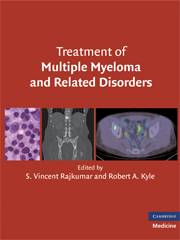Book contents
- Frontmatter
- Contents
- List of Contributors
- 1 DIAGNOSIS AND GENETIC CLASSIFICATION OF MULTIPLE MYELOMA
- 2 STAGING AND RISK-STRATIFICATION OF MULTIPLE MYELOMA
- 3 TREATMENT OF NEWLY DIAGNOSED MULTIPLE MYELOMA
- 4 MAINTENANCE THERAPY IN MULTIPLE MYELOMA
- 5 TREATMENT OF RELAPSED AND RELAPSED/REFRACTORY MULTIPLE MYELOMA
- 6 DIAGNOSIS AND TREATMENT OF MYELOMA BONE DISEASE
- 7 TREATMENT OF MYELOMA-RELATED COMPLICATIONS
- 8 AUTOLOGOUS TRANSPLANTATION FOR MULTIPLE MYELOMA
- 9 ALLOGENEIC STEM CELL TRANSPLANTATION FOR MULTIPLE MYELOMA
- 10 IMMUNOGLOBULIN LIGHT CHAIN AMYLOIDOSIS
- 11 WALDENSTRÖM MACROGLOBULINEMIA/LYMPHOPLASMACYTIC LYMPHOMA
- 12 DIAGNOSIS, RISK-STRATIFICATION, AND MANAGEMENT OF SOLITARY PLASMACYTOMA
- 13 MONOCLONAL GAMMOPATHY OF UNDETERMINED SIGNIFICANCE AND SMOLDERING MULTIPLE MYELOMA
- 14 DIAGNOSIS AND TREATMENT OF POEMS SYNDROME
- Index
- References
1 - DIAGNOSIS AND GENETIC CLASSIFICATION OF MULTIPLE MYELOMA
Published online by Cambridge University Press: 11 July 2009
- Frontmatter
- Contents
- List of Contributors
- 1 DIAGNOSIS AND GENETIC CLASSIFICATION OF MULTIPLE MYELOMA
- 2 STAGING AND RISK-STRATIFICATION OF MULTIPLE MYELOMA
- 3 TREATMENT OF NEWLY DIAGNOSED MULTIPLE MYELOMA
- 4 MAINTENANCE THERAPY IN MULTIPLE MYELOMA
- 5 TREATMENT OF RELAPSED AND RELAPSED/REFRACTORY MULTIPLE MYELOMA
- 6 DIAGNOSIS AND TREATMENT OF MYELOMA BONE DISEASE
- 7 TREATMENT OF MYELOMA-RELATED COMPLICATIONS
- 8 AUTOLOGOUS TRANSPLANTATION FOR MULTIPLE MYELOMA
- 9 ALLOGENEIC STEM CELL TRANSPLANTATION FOR MULTIPLE MYELOMA
- 10 IMMUNOGLOBULIN LIGHT CHAIN AMYLOIDOSIS
- 11 WALDENSTRÖM MACROGLOBULINEMIA/LYMPHOPLASMACYTIC LYMPHOMA
- 12 DIAGNOSIS, RISK-STRATIFICATION, AND MANAGEMENT OF SOLITARY PLASMACYTOMA
- 13 MONOCLONAL GAMMOPATHY OF UNDETERMINED SIGNIFICANCE AND SMOLDERING MULTIPLE MYELOMA
- 14 DIAGNOSIS AND TREATMENT OF POEMS SYNDROME
- Index
- References
Summary
INTRODUCTION
In the past decade we have seen great advances in our understanding of the genetic abnormalities present in multiple myeloma (MM) cells, which is believed to be the culprit in the pathogenesis of this disease. This progress has been, in great part, facilitated by the advent of novel molecular genetic and cytogenetic techniques, as well as the unparalleled power available through the genomic revolution. Furthermore, the continued testing for many of these genetic aberrations in large cohorts of patients has allowed for an increasingly accurate description of oncogenomics using primary patient samples. The translation and testing of this basic knowledge in these patient cohorts has provided clinical relevance that truly spans from the bench to the bedside. While much progress has been made in the understanding of the disease, many questions remain, particularly those capable of addressing progression events from the benign stages and unraveling complex interactions supporting clonal survival and evolution. In this chapter we discuss the knowledge regarding a global overview of genetic aberrations of MM cells, primary genetic lesions, secondary genetic events, and, lastly, their clinical implications.
GLOBAL OVERVIEW OF MM GENETICS
At the top hierarchical level, human MM can be divided into two diseases: hyperdiploid MM (H-MM) and nonhyperdiploid MM (NH-MM). The dichotomy separation of MM into these two entities is appealing from the didactic perspective and is clearly substantiated by an extensive body of literature.
- Type
- Chapter
- Information
- Treatment of Multiple Myeloma and Related Disorders , pp. 1 - 17Publisher: Cambridge University PressPrint publication year: 2008
References
- 1
- Cited by



